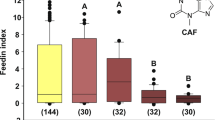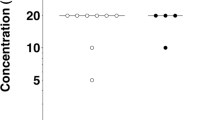Abstract
Theories of plant chemical defenses discriminate between quantitative digestibility reducers (e.g., tannins) and qualitative toxins (e.g., alkaloids). Since the differential effect on taste of these compounds is poorly known, we recorded ingestive responses of a primate species, Microcebus murinus, to four tannin-rich plant extracts and to quinine, by using the behavioral method of the “two-bottle test.” The efficiency of tannic extracts at precipitating protein was measured with the blue BSA method. Inhibition taste thresholds for tannins added to a moderately sweet solution varied between 0.25 and 2 g/l. The threshold for quinine hydrochloride was 0.32 g/l. The profiles of the response/concentration curves established for these astringent and bitter substances were similar, with maximal inhibition of consumption occurring for near-threshold concentrations. The large amounts of quinine required to deter this small-bodied species from feeding were unexpected, given its unspecialized frugivorous/insectivorous diet. We propose that the taste responses of Microcebus to tannins have been shaped in relation to the widespread occurrence of efficient polyphenols in food plants, while low responsiveness to quinine reflects a low risk of ingesting toxic alkaloids when feeding on ripe fruits and insects.
Similar content being viewed by others
REFERENCES
Asquith, T. N. and Butler, L. G. 1985. Use of a dye-labeled protein as spectrophotometric assay for protein precipitants such as tannin. J. Chem. Ecol. 11:1535–1544.
Atsalis, S. 1999. Diet of the brown mouse lemur (Microcebus rufus) in Ranomafana National Park, Madagascar. Int. J. Primatol. 20:193–229.
Barton, R. A., Whiten, A., Byrne, R.W., and English, M. 1993. Chemical composition of baboon plant foods: implications for the interpretation of intra-and interspecific differences in diet. Folia Primatol. 61:1–20.
Coley, P. D., Bryant, J. P., and Chapin, F. S., III 1985. Resource availability and plant antiherbivore defense. Science 230:895–899.
Danilova, V., Hellekant, G., Roberts, T., Tinti, J.-M., and Nofre, C. 1998. Behavioral and single chorda tympani taste fiber responses in the common marmoset, Callithrix jacchus jacchus. Ann. NY Acad. Sci. 855:160–164.
Feeny, P. 1976. Plant apparency and chemical defense. Recent. Adv. Phytochem. 10:1–40.
Fraenkel, G. S. 1959. The raison d'étre of secondary plant substances. Science 129:1466–1470.
Ganzhorn, J. U. 1988. Food partitioning among Malagasy Primates. Oecologia 75:436–450.
Glaser, D. 1986. Geschmacksforschung bei Primaten. Vjschr. Naturf. Ges. ZÜrich 131/2: 92–110.
Hellekant, G., Hladik, C. M., Dennys, V., Simmen, B., Roberts, T.W., and Glaser, D. 1993a. On the relationship between sweet taste and seasonal body weight changes in a primate (Microcebus murinus). Chem. Senses 18:27–33.
Hellekant, G., Hladik, C. M., Dennys, V., Simmen, B., Roberts, T. W., Glaser, D., DuBois, G., and Walters, D. E. 1993b. On the sense of taste in two Malagasy primates (Microcebus murinus and Eulemur mongoz). Chem. Senses 18:307–320.
Herrera, C. M. 1985. Determinants of plant-animal coevolution: the case of mutualistic dispersal of seeds by vertebrates. Oikos 44:132–141.
Hladik, C. M., Charles-Dominique, P., and Petter, J. J. 1980. Feeding strategies of five nocturnal prosimians in the dry forest of the west coast of Madagascar, pp. 41–73, in P. Charles-Dominique, H. M. Cooper, A. Hladik, C. M. Hladik, E. Pagés, G. F. Pariente, A. Petter-Rousseaux, J. J. Petter and A. Schillings (eds.). Nocturnal Malagasy Primates. Ecology, Physiology, and Behavior. Academic Press, New York. 2326 IACONELLI AND SIMMEN
Hladik, C. M., Pasquet, P., and Simmen, B. 2002. New perspectives on taste and primate evolution: the dichotomy in gustatory coding for perception of beneficent versus noxious substances as supported by correlations among human thresholds. Am. J. Phys. Anthrop. 117:342–348.
Iaconelli, S. 2000. La perception gustative des substances secondaires chez les primates: cas des tannins et d'un alcaloïde chez un prosimien (Microcebus murinus) et dans diff´erents échantillons de populations humaines. PhD thesis. University of Paris XIII.
Iaconelli, S. and Simmen, B. 1999. Palatabilité de l'acide tannique dans une solution sucrée chez Microcebus murinus: variation saisonniére et implication dans le comportement alimentaire. Primatologie 2:421–434.
Laska, M. 2000. Gustatory responsiveness to food-associated sugars and acids in pigtail macaques, Macaca nemestrina. Physiol. Behav. 70:495–504.
Maisels, F., Gautier-Hion, A., and Gautier, J. P. 1994. Diets of two sympatric colobines in Zaire: more evidence on seed-eating in forests on poor soils. Int. J. Primatol. 15:681–701.
Martin, R. D. 1972. A preliminary field-study of the lesser mouse lemur (Microcebus murinus J.F. Miller 1777). Z. Tierpsychol. Suppl. 9:43–89.
McKey, D. 1974. Adaptive patterns in alkaloid physiology. Am. Nat. 108:305–320.
McManus, J., Davis, K., Lilley, T., and Haslam, E. 1981. The association of proteins with phenols. J. Chem. Soc. Commun. 7:309–311.
Perret, M. and Schilling, A. 1987. Intermale sexual effect elicited by volatile urinary ether extract in Microcebus murinus (Prosimian, Primates). J. Chem. Ecol. 13:495–507.
Remis, M. J. and Kerr, M. E. 2002. Taste responses to fructose and tannic acid among gorillas (Gorilla gorilla gorilla). Int. J. Primatol. 23:251–261.
Schiffman, S. S., Suggs, M., Sostman, A., and Simon, S. 1992. Chorda tympani and lingual nerve responses to astringent compounds in rodents. Physiol. Behav. 51:55–63.
Simmen, B. 1994. Taste discrimination and diet differentiation among New World primates, pp. 150–165, in D. J. Chivers and P. Langer (eds.). The Digestive System in Mammals: Food, Form and Function. Cambridge University Press, Cambridge.
Simmen, B., Hladik, A., Ramasiarisoa, P. L., Iaconelli, S., and Hladik, C. M. 1999a. Taste discrimination in lemurs and other primates, and the relationships to distribution of plant allelochemicals in different habitats of Madagascar, pp. 201–219, in B. Rakotosamimanana, H. Rasamimanana, J. U. Ganzhorn and S. J. Goodman (eds.). New Directions in Lemur Studies. Kluwer Academic/Plenum Publishers, New York.
Simmen, B. and Hladik, C. M. 1988. Seasonal variation of taste threshold for sucrose in a prosimian species, Microcebus murinus. Folia Primatol. 51:152–157.
Simmen, B. and Hladik, C.M. 1998. Sweet and bitter taste discrimination in primates: scaling effects across species. Folia Primatol. 69: 129–138.
Simmen, B., Josseaume, B., and Atramentowicz, M. 1999b. Frugivory and taste responses to fructose and tannic acid in a prosimian primate and a didelphid marsupial. J. Chem. Ecol. 25:331–346.
Simmen, B. and Sabatier, D. 1996. Diets of some French Guianan primates: food composition and food choices. Int. J. Primatol. 17:661–693.
Steiner, J. E. and Glaser D. 1984. Differential behavioral responses to taste stimuli in nonhuman Primates. J. Hum. Evol. 13:709–723.
Swain, T. 1979. Tannins and lignins, pp. 657–682, in G. A. Rosenthal and D. H. Janzen (eds). Herbivores, Their Interaction with Secondary Plant Metabolites. Academic Press, New York.
Wrangham, R.W., Conklin-Brittain, N. L., and Hunt, K.D. 1998. Dietary reponse of chimpanzees and cercopithecines to seasonal variation in fruit abundance. I. Antifeedants. Int. J. Primatol. 19:949–970.
Author information
Authors and Affiliations
Rights and permissions
About this article
Cite this article
Iaconelli, S., Simmen, B. Taste Thresholds and Suprathreshold Responses to Tannin-Rich Plant Extracts and Quinine in a Primate Species (Microcebus murinus). J Chem Ecol 28, 2315–2326 (2002). https://doi.org/10.1023/A:1021061602368
Issue Date:
DOI: https://doi.org/10.1023/A:1021061602368




